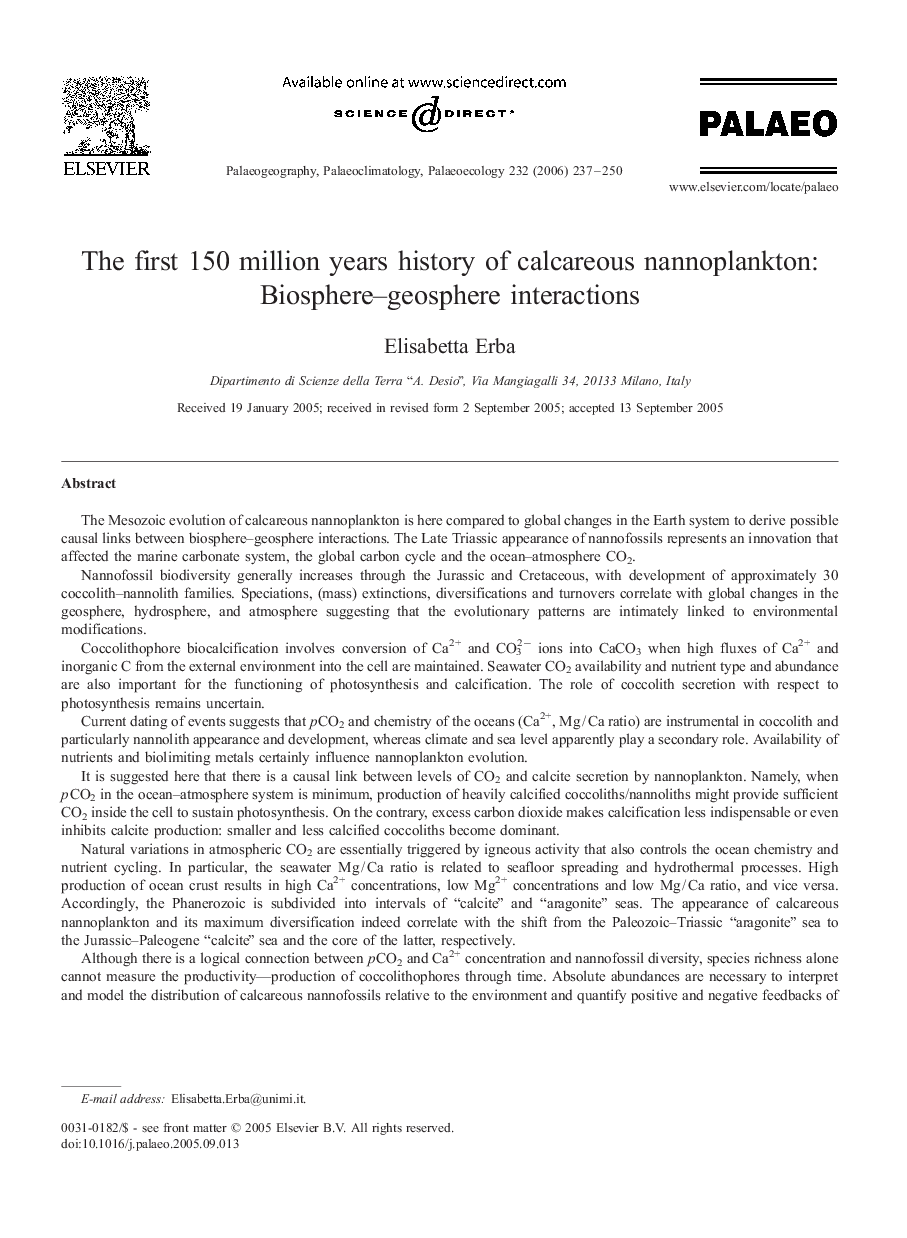| کد مقاله | کد نشریه | سال انتشار | مقاله انگلیسی | نسخه تمام متن |
|---|---|---|---|---|
| 4469603 | 1622377 | 2006 | 14 صفحه PDF | دانلود رایگان |

The Mesozoic evolution of calcareous nannoplankton is here compared to global changes in the Earth system to derive possible causal links between biosphere–geosphere interactions. The Late Triassic appearance of nannofossils represents an innovation that affected the marine carbonate system, the global carbon cycle and the ocean–atmosphere CO2.Nannofossil biodiversity generally increases through the Jurassic and Cretaceous, with development of approximately 30 coccolith–nannolith families. Speciations, (mass) extinctions, diversifications and turnovers correlate with global changes in the geosphere, hydrosphere, and atmosphere suggesting that the evolutionary patterns are intimately linked to environmental modifications.Coccolithophore biocalcification involves conversion of Ca2+ and CO32− ions into CaCO3 when high fluxes of Ca2+ and inorganic C from the external environment into the cell are maintained. Seawater CO2 availability and nutrient type and abundance are also important for the functioning of photosynthesis and calcification. The role of coccolith secretion with respect to photosynthesis remains uncertain.Current dating of events suggests that pCO2 and chemistry of the oceans (Ca2+, Mg / Ca ratio) are instrumental in coccolith and particularly nannolith appearance and development, whereas climate and sea level apparently play a secondary role. Availability of nutrients and biolimiting metals certainly influence nannoplankton evolution.It is suggested here that there is a causal link between levels of CO2 and calcite secretion by nannoplankton. Namely, when pCO2 in the ocean–atmosphere system is minimum, production of heavily calcified coccoliths/nannoliths might provide sufficient CO2 inside the cell to sustain photosynthesis. On the contrary, excess carbon dioxide makes calcification less indispensable or even inhibits calcite production: smaller and less calcified coccoliths become dominant.Natural variations in atmospheric CO2 are essentially triggered by igneous activity that also controls the ocean chemistry and nutrient cycling. In particular, the seawater Mg / Ca ratio is related to seafloor spreading and hydrothermal processes. High production of ocean crust results in high Ca2+ concentrations, low Mg2+ concentrations and low Mg / Ca ratio, and vice versa. Accordingly, the Phanerozoic is subdivided into intervals of “calcite” and “aragonite” seas. The appearance of calcareous nannoplankton and its maximum diversification indeed correlate with the shift from the Paleozoic–Triassic “aragonite” sea to the Jurassic–Paleogene “calcite” sea and the core of the latter, respectively.Although there is a logical connection between pCO2 and Ca2+ concentration and nannofossil diversity, species richness alone cannot measure the productivity—production of coccolithophores through time. Absolute abundances are necessary to interpret and model the distribution of calcareous nannofossils relative to the environment and quantify positive and negative feedbacks of coccolithophore biocalcification. Improved chronology of paleobiological and geological events will be crucial for the understanding of evolutionary processes.
Journal: Palaeogeography, Palaeoclimatology, Palaeoecology - Volume 232, Issues 2–4, 22 March 2006, Pages 237–250